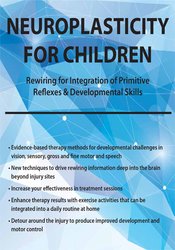🔥 Today Special 🔥
Enjoy 25% OFF on all products! Use code: BRAINLEARNS to save. Offer valid until midnight!
Available for Pre-Order. This product will be available within a few days.
Karen Pryor – Neuroplasticity for Children

Understanding Neuroanatomy & Brain Development
- Brain stem and functions
- Occipital lobe
- Temporal lobe
- Frontal lobe
- Parietal lobe
Brain Damage & Missing Parts
- Neurodevelopmental screens
- Examples of damage
- What is working and what is not
- Where to rewire
- Therapy as infants – faster change
- Going deep into the brain, beyond the level of damage
Developmental Delays
How to Approach Treatments
- Developmental milestone review
- Sensory motor development
- Vision
- Vision and hearing
- Speech
- Sensation
- Primitive reflex patterns and influence
- Opening the hands for exploration
- Developmental delay and when to go back a step in therapy treatments
A New Perspective on the Nervous System & Guiding for Positive Change
- Lobes next door
- Videos of before and after sensory stimulation combinations
- Why vision is vitally important and how it can be stimulated
- How these concepts can be explained to parents and caregivers
- The brain is clay and how to make a model
The Primary & Secondary Results of Neuroplasticity Techniques
- Changing the way the brain connects
- Primitive reflex integration and increased active movements
- The “Team” – patient, therapist, and parent/caregiver
- Sensory stimulation to promote appropriate motor response
- Smooth movements
- Strength is not the same as tone
- Simple activities to present to parents
How to Integrate Neuroplasticity into your Therapy Program
- Sensation is 3-dimensional
- Climb through the cloth tube
- Vision exercises
- Sensory stimulation for high tone vs. low tone
Would you like to receive Karen Pryor – Neuroplasticity for Children ?
Description:
Studies show our brains can be rewired to enhance new learning. In some cases, it acts as an adaptive mechanism to compensate for lost function or maximize remaining function in the event of brain injury. As therapists, when we treat the causes and symptoms of these motor delays, we can utilize alternate brain pathways to improve the effects of therapy.
Neuroplasticity changes brain connections and hence, changes motor and cognitive functions. From congenital abnormalities to traumatic brain injuries, this course delivers new and exciting ideas on how to detour around damage and incorporate viable nervous system connections.
Learn how therapy can change the brain and how neuroplasticity can change the challenges in a child’s development. With Dr. Karen Pryor as your guide, you gain creative and evidence-based approaches to incorporate into a multisensory experience to drive home the importance of diverse and novel activities during treatment sessions.
Both high and low tones are discussed in depth. Video case studies will demonstrate changes before and after integrative neuroplasticity treatments. The therapy techniques learned in this one-day course can be easily integrated into the clinic or home the next day.
Course Features
- Lectures 0
- Quizzes 0
- Duration Lifetime access
- Skill level All levels
- Students 0
- Assessments Yes





